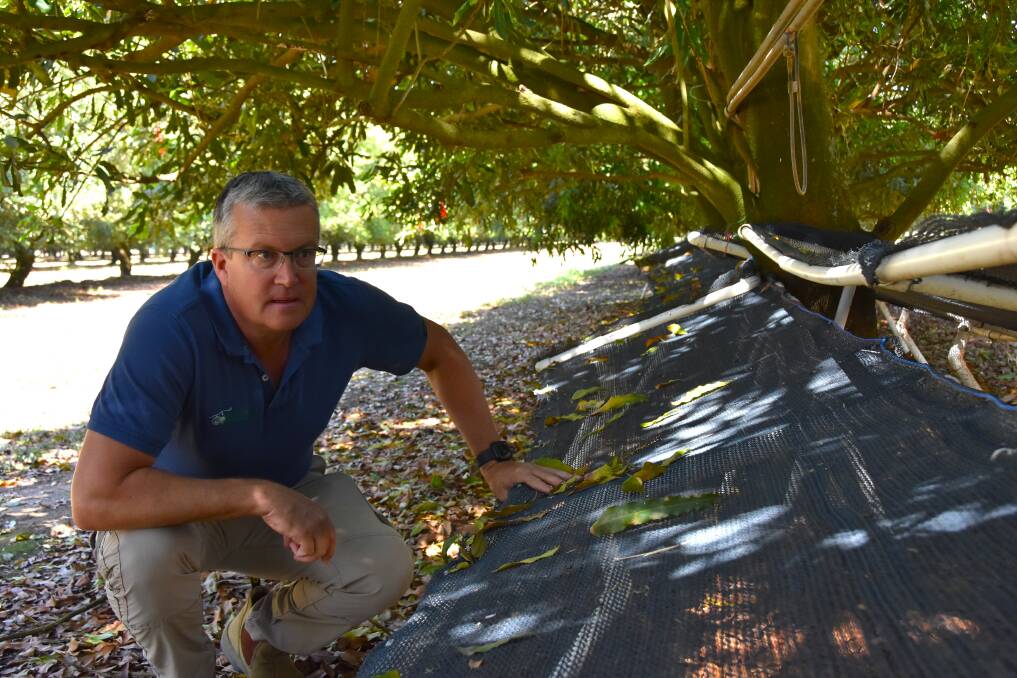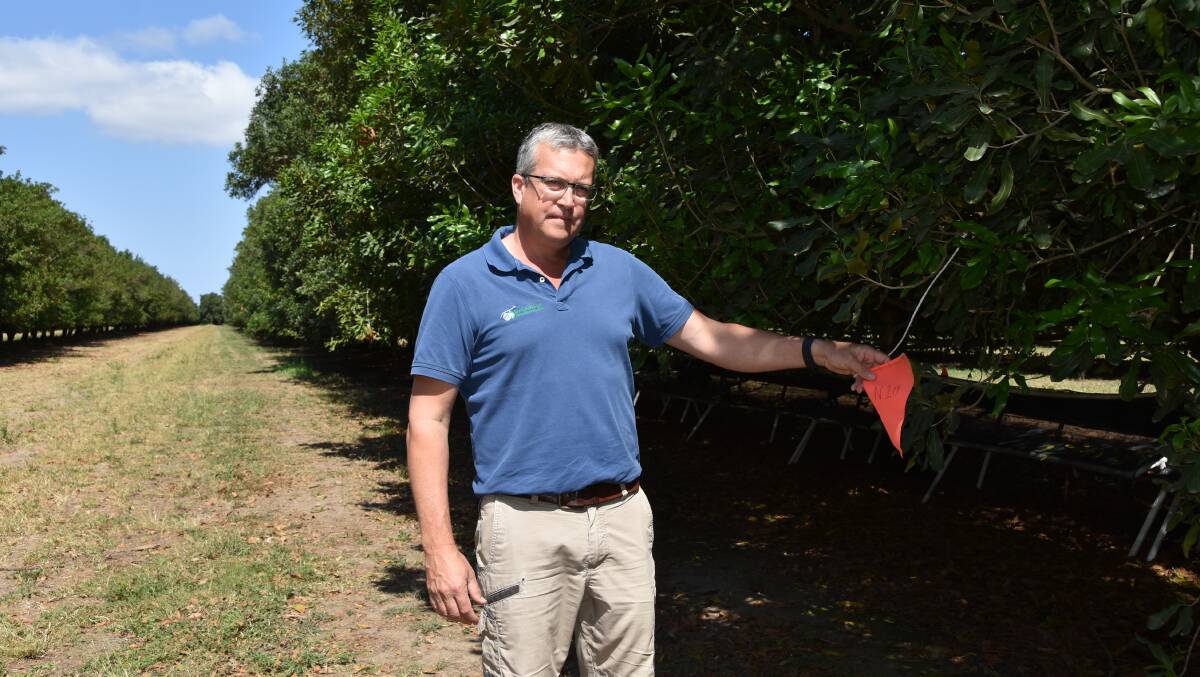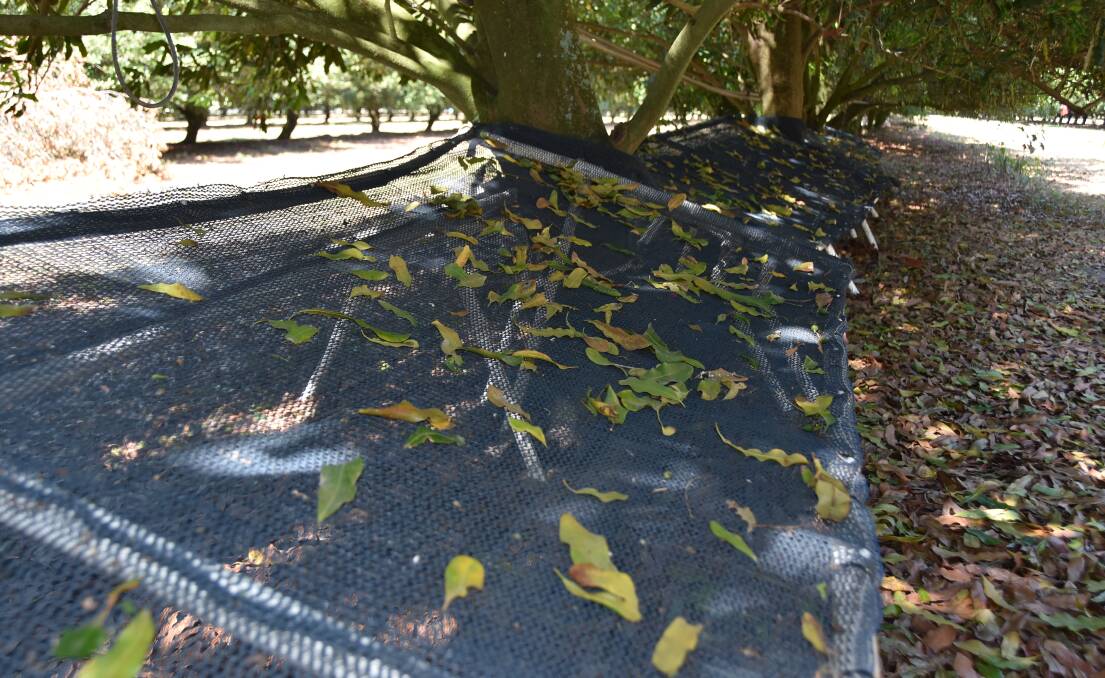Researchers look at net benefits for macadamias

This is branded content for Department of Agriculture and Fisheries
AN easier collection method for nuts may be a byproduct of a trial using netting placed underneath macadamia trees.
That's one of the early observations emerging from a five year trial happening at one of Macadamia Farm Management's (MFM) Welcome Creek orchards, just north of Bundaberg.
The Queensland Department of Agriculture and Fisheries (DAF) is conducting the trial in association with MFM to assess the benefits of under-tree netting in terms of retaining more mulch and therefore improving soil structure and moisture retention.
Macadamia nuts are generally harvested using a sweeper or fingerwheel which runs underneath the tree's canopy, brushing the nuts out to then be collected by machine.
While efficient, the process tends to remove the valuable mulch, made up largely of fallen leaves, which help protect the tree's root system and soil biodiversity.
The idea behind the netting is to deflect the falling nuts toward the interrow, increasing machinery harvesting effectiveness.
The trial has been refined over the past two years with the current fixed system operating since January this year. It consists of PVC pipe frames with mesh stretched across, positioned on an angle from about 30cm off the ground at the lowest point, up toward the tree trunk, about 20cm higher.
The netting trial runs for about 25m.
PVC has been chosen for the frames as timber would rot due to the moisture and shade, while steel would rust due to the same conditions, particularly in coastal orchards.

The trial is currently under trees which are 34 years old, and the netting is mostly shaded. In a younger orchard with a less established canopy, the netting would need to be UV-stabilised to endure the constant sunlight, which creates another cost consideration.
Researchers will monitor the potential organic matter increase below the trees to see if irrigation can be reduced.
DAF monitored a similar trial in the Gympie region in recent years and found nut yields improved by an average of 20 per cent for the netted trees. The trial also found soil organic matter increased by 50pc, with the weight of the roots around the trunks also increasing.
Toward better sustainability
SCOTT Allcott, director, MFM said the trial was all in the name of finding more sustainable farming systems.
"With the cost of water, the cost of diesel; if we can run this ground less often and pick up the nut in a closer area, it will be beneficial," he said.
Macadamia nuts fall over a four month period and a harvest is taken every three to four weeks depending on weather. That can mean significant traffic up and down orchard rows.
The fewer machinery wheels going near the base of the tree the better as there is less compaction, which benefits the soil structure and also has long term benefits in reducing soil erosion and run-off, thereby helping to improve reef water quality.

Mr Allcott said the trial will require the full five years in order to collect enough nutritional data on soil health and monitor water use.
"It has to be five years simply because of the nature of it. Measuring organic matter increases, nutrition and water, taking weather and other variables into play, you've got to have extended periods of time to take the variables out of it," he said.
"We are running the course of this trial to see what increases, find some value and then we'll probably look at attempting to try and keep the nut off the ground."
Catching the nut before it hits the floor would not only lessen the risk of rats feasting on a dropped crop but would also mean improved nut quality.
"When the nut is lying on the ground it gets moist and dry, moist and dry; that's where you'll get discolouration of your kernel," Mr Allcott said.
"And you get mould and that sort of thing on the ground, so keeping nuts off the ground would preserve their appearance and quality."

High quality, blemish-free nuts attract a premium price with processors.
One thought has been to create a gutter system where the nuts would roll into a collection channel to then be sucked up with an industrial vacuum of sorts.
"If we can keep the nut off the ground, we will probably use a sucker system in a gutter where it might suck the stick and leaf and extract that within the machine. Those are all just concepts that we have to prove once we see some value in doing this," he said.
Beyond the box
WITH 18 years' experience in the macadamia industry, Mr Allcott said such projects, while perhaps seen as a little way-out at this point, need to be embraced.
"We've really got to look outside the square, so to speak, and try and find better ways to stretch the water further, stretch organic matter further and potentially apply less synthetics.

"That's an ideal and we are looking at a physical barrier here of the netting under the tree but it's designed to reduce run-off because you are not disturbing the soil as much.
"The benefits aren't always directly seen and they will be measured over the next five years, so we will see what happens. If there are no benefits, you don't go forward. If the benefits are there, you implement them, so the value has to be there to spend the money.
"We've got to do more to be more sustainable."
- To find out about innovations and techniques to improve practices on-farm in reef catchments, call DAF on 13 25 23 or visit qld.gov.au/FarminginReefCatchments
This is branded content for Department of Agriculture and Fisheries


